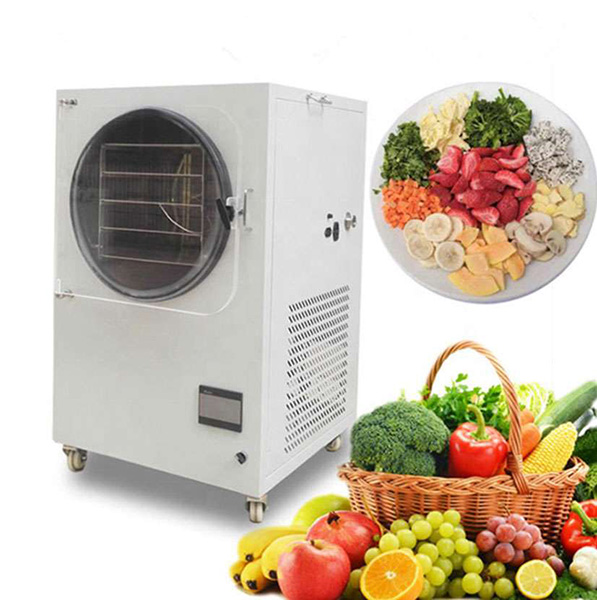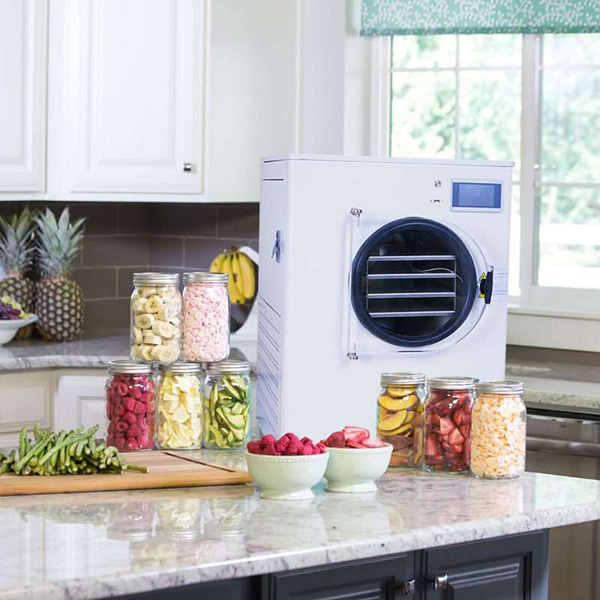
Content Menu
● Introduction to Freeze Drying Technology
● Understanding the Freeze Drying Process
● Types of Freeze Dried Food Machines
>> Home Freeze Dryers
>> Commercial and Industrial Freeze Dryers
● Benefits of Using a Freeze Dried Food Machine
>> Long-Term Food Storage
>> Nutritional Preservation
>> Flavor and Texture Retention
>> Versatility
● Choosing the Right Freeze Dried Food Machine
>> Capacity
>> Size and Space Requirements
>> Energy Efficiency
>> Ease of Use
>> Maintenance Requirements
● Operating Your Freeze Dried Food Machine
● Innovations in Freeze Drying Technology
● Applications Beyond Food Preservation
● The Future of Freeze Drying
● Conclusion
● Frequently Asked Questions
>> 1. How long does the freeze drying process take?
>> 2. Can all foods be freeze-dried?
>> 3. How do freeze-dried foods compare to dehydrated foods?
>> 4. What is the shelf life of freeze-dried foods?
>> 5. Are home freeze dryers worth the investment?
Introduction to Freeze Drying Technology
Freeze drying, also known as lyophilization, is a cutting-edge food preservation method that has gained significant popularity in recent years. At the heart of this process is the freeze dried food machine, a sophisticated piece of equipment that allows both home enthusiasts and commercial operators to preserve a wide variety of foods for extended periods. In this comprehensive guide, we'll explore the world of freeze drying, focusing on the machines that make this remarkable process possible.
Understanding the Freeze Drying Process
Before delving into the specifics of freeze dried food machines, it's essential to understand the basic principles of the freeze drying process. Unlike traditional dehydration methods, freeze drying involves three main steps:
1. Freezing: The food is rapidly frozen to preserve its structure.
2. Primary drying: The frozen water in the food is removed through sublimation, where ice turns directly into vapor without passing through the liquid state.
3. Secondary drying: Any remaining moisture is removed through desorption.
This process results in food that retains its original shape, color, and nutritional value, making it an ideal method for long-term food preservation.

Types of Freeze Dried Food Machines
Home Freeze Dryers
The home freeze dryer has revolutionized food preservation for individual households. These compact units are designed to fit in most kitchens and allow families to preserve their own fruits, vegetables, meats, and even complete meals. Home freeze dryers typically feature:
- Digital control panels for easy operation
- Multiple trays for batch processing
- Programmable cycles for different food types
- Quiet operation for residential use
Commercial and Industrial Freeze Dryers
For larger operations, commercial and industrial freeze dryers offer increased capacity and efficiency. These machines are used by food manufacturers, pharmaceutical companies, and large-scale food preservation facilities. Key features include:
- Large-capacity chambers for bulk processing
- Advanced control systems for precise temperature and pressure management
- Automated loading and unloading systems
- Enhanced energy efficiency for continuous operation
Benefits of Using a Freeze Dried Food Machine
Investing in a freeze dried food machine offers numerous advantages for both home users and businesses:
Long-Term Food Storage
One of the primary benefits of freeze drying is the ability to store food for extended periods. Properly freeze-dried foods can last up to 25 years when stored correctly, making them ideal for emergency preparedness, outdoor enthusiasts, and those looking to reduce food waste.
Nutritional Preservation
Unlike other preservation methods, freeze drying retains up to 97% of the food's original nutritional value. This makes it an excellent choice for health-conscious consumers who want to enjoy nutritious foods year-round.
Flavor and Texture Retention
Freeze-dried foods maintain their original flavor profiles and rehydrate to closely resemble their fresh counterparts. This is particularly important for gourmet ingredients and specialty foods.

Versatility
A freeze dried food machine can process a wide range of foods, including:
- Fruits and vegetables
- Meats and seafood
- Dairy products
- Complete meals and desserts
- Herbs and spices
This versatility makes it a valuable tool for diverse culinary applications and food preservation needs.
Choosing the Right Freeze Dried Food Machine
When selecting a freeze dried food machine, consider the following factors:
Capacity
Determine how much food you plan to process regularly. Home units typically handle 4-10 pounds of fresh food per batch, while commercial machines can process hundreds of pounds at a time.
Size and Space Requirements
Ensure you have adequate space for the machine, considering both its footprint and any additional equipment like vacuum pumps.
Energy Efficiency
Look for models with energy-saving features, as freeze drying can be an energy-intensive process.
Ease of Use
Choose a machine with user-friendly controls and clear instructions, especially if you're new to freeze drying.
Maintenance Requirements
Consider the ongoing maintenance needs, such as oil changes for the vacuum pump and cleaning procedures.

Operating Your Freeze Dried Food Machine
To get the most out of your freeze dried food machine, follow these best practices:
1. Prepare food properly by cutting it into uniform pieces for even drying.
2. Pre-freeze foods when possible to reduce overall processing time.
3. Arrange food on trays with adequate spacing for optimal air circulation.
4. Follow the manufacturer's guidelines for different food types and adjust cycles accordingly.
5. Allow the machine to complete its full cycle without interruption for best results.
6. Properly package freeze-dried foods in airtight containers or mylar bags with oxygen absorbers.
Innovations in Freeze Drying Technology
The field of freeze drying is constantly evolving, with new innovations enhancing the efficiency and capabilities of freeze dried food machines. Some recent advancements include:
- Improved vacuum pump technology for faster processing times
- Smart controls that adjust parameters based on food type and moisture content
- Integration with mobile apps for remote monitoring and control
- Enhanced energy recovery systems to reduce operating costs
These innovations are making freeze drying more accessible and cost-effective for a wider range of users.
Applications Beyond Food Preservation
While food preservation is the primary use for freeze dried food machines, the technology has applications in various other fields:
- Pharmaceuticals: Preserving sensitive medications and vaccines
- Biotechnology: Stabilizing biological samples for research
- Taxidermy: Preserving animal specimens
- Floral preservation: Creating long-lasting flower arrangements
This versatility demonstrates the broad impact of freeze drying technology across multiple industries.
The Future of Freeze Drying
As concerns about food security and sustainability grow, the importance of efficient food preservation methods like freeze drying is likely to increase. We can expect to see further advancements in freeze dried food machine technology, including:
- More compact and affordable home units
- Increased automation in commercial systems
- Integration with sustainable energy sources
- Development of new materials for improved efficiency
These developments will continue to make freeze drying an essential tool in our efforts to reduce food waste and ensure long-term food security.
Conclusion
Freeze dried food machines represent a significant leap forward in food preservation technology. Whether you're a home user looking to extend the life of your garden's harvest or a commercial operator seeking to expand your product line, freeze drying offers unparalleled benefits in terms of food quality, nutrition, and longevity. By understanding the principles behind freeze drying and choosing the right equipment, you can harness the power of this remarkable technology to transform the way you approach food preservation and storage.
Frequently Asked Questions
1. How long does the freeze drying process take?
The freeze drying process typically takes between 20 to 40 hours, depending on the food type, moisture content, and the specific machine being used. Some home units may take up to 48 hours for a complete cycle.
2. Can all foods be freeze-dried?
While most foods can be freeze-dried, some are better suited to the process than others. Foods with high fat content, such as avocados, may not freeze-dry well. However, fruits, vegetables, meats, dairy products, and even complete meals can be successfully freeze-dried.
3. How do freeze-dried foods compare to dehydrated foods?
Freeze-dried foods generally retain more of their original flavor, texture, and nutritional value compared to dehydrated foods. They also rehydrate more quickly and completely. However, freeze drying equipment is typically more expensive than dehydrators.
4. What is the shelf life of freeze-dried foods?
Properly packaged freeze-dried foods can last up to 25 years when stored in optimal conditions. This makes them ideal for long-term storage and emergency preparedness.
5. Are home freeze dryers worth the investment?
For many households, a home freeze dryer can be a worthwhile investment, especially for those who grow their own produce, buy in bulk, or want to ensure a long-term food supply. The initial cost is significant, but the ability to preserve a wide variety of foods with their nutritional value intact can lead to savings over time and provide peace of mind for emergency situations.












